The Status of the Early-Stage Fish Resources and Hydrologic Influencing Conditions in the Guiping Section of the Xunjiang River
Abstract
1. Introduction
2. Materials and Methods
2.1. Sampling Methods
2.2. Identification of Fish Eggs and Larvae Species
2.3. Data Processing and Analysis
2.3.1. Calculation of Fish Density and Abundance
2.3.2. Determination of Spawning Ground Location
2.3.3. Analysis Methods for Fish Breeding Season and Hydrological Factors
3. Results
3.1. Species Composition
3.2. Dominant Species
3.2.1. Interannual Variation in Dominant Species Composition
3.2.2. Seasonal Recruitment Patterns
3.2.3. Temporal Patterns of Recruitment Peaks
3.2.4. Linkage to Hydrological Conditions
3.3. Hydrological Dynamics and Ichthyoplankton Recruitment Response
3.3.1. Hydrological Conditions and Fish Recruitment in 2022
3.3.2. Hydrological Conditions and Fish Recruitment in 2023
3.3.3. Monthly Distribution of Fish Eggs and Larvae
3.4. The Location and Scale of Spawning Ground
3.5. Relationship Between Fish Resources and Hydrological Environment
4. Discussion
4.1. The Dynamics of Fish Eggs and Larvae
4.2. The Promotive Effect of Flood Pulses on Fish Reproduction and Interannual Differences
4.3. Multivariate Analysis of the Impact of Environmental Factors on the Density of the Fish Resources in Early Stage
5. Conclusions
Supplementary Materials
Author Contributions
Funding
Institutional Review Board Statement
Informed Consent Statement
Data Availability Statement
Conflicts of Interest
References
- Cao, W.X.; Chang, J.B.; Qiao, Y. Early Life Stages of Fish in the Yangtze River; China Water Power Press: Beijing, China, 2007. [Google Scholar]
- Chambers, R.C.; Trippel, E.A. Early Life History and Recruitment in Fish Populations; Chapman and Hall Fish and Fisheries Series; Springer Science & Business Media: New York, NY, USA, 1997. [Google Scholar]
- Blaxter, J.H.S.; Holliday, F.G.T. The Behaviour and Physiology of Herring and Other Clupeids. Adv. Mar. Biol. 1963, 1, 261–394. [Google Scholar]
- Buckley, J.; James, I. Linear Regression with Censored Data. Biometrika 1979, 66, 429–436. [Google Scholar] [CrossRef]
- Miller, D. Some Organizational Consequences of CEO Succession. Acad. Manag. J. 1993, 36, 644–659. [Google Scholar] [CrossRef]
- Kendall, P.C. Treating Anxiety Disorders in Children: Results of a Randomized Clinical Trial. J. Consult. Clin. Psychol. 1994, 62, 100. [Google Scholar] [CrossRef]
- Tataje, R.A.D.; Lopes, A.C.; Massaro, V.M.; Hartmann, P.B.; Sulzbacher, R.; Santos, J.A.; Bialetzki, A. State of the Art of Identification of Eggs and Larvae of Freshwater Fish in Brazil. Acta Limnol. Bras. 2020, 32, e6. [Google Scholar]
- Wang, C.X. Species Identification of Wild Fish Larvae in the Middle Yangtze River. Acta Hydrobiol. Sin. 1959, 3, 315–343. [Google Scholar]
- Liang, Z.S.; Mo, R.L.; Chen, F.C. Taxonomic Identification and Spawning Types of Early Development of Common Fish in the Xijiang River. Pearl River Fish. Resour. Investig. Res. Rep. 1985, 6, 21–25. [Google Scholar]
- Tan, X.C.; Li, X.H.; Tao, J.P.; Li, J.; Wang, C.; Luo, J.; Lai, Z.N. Spatial and Temporal Distribution Characteristics of Early Fish Resources in the Zhaoqing Section of the Xijiang River. Freshw. Fish. 2007, 4, 37–40. [Google Scholar]
- Li, C. Species Identification of Fish Larvae and Current Status of Dominant Species Resources in the Xijiang River. Ph.D. Thesis, Shanghai Ocean University, Shanghai, China, 2019. [Google Scholar]
- Wu, J.M.; Wang, Q.Q.; Li, F.; Liu, C.C.; Zhang, F.T.; Wang, J.W. Fish Resources of Early Life in Chishui Section of the Chishui River. Resour. Environ. Yangtze Basin 2010, 19, 1270. [Google Scholar]
- Heiner, M.; Higgins, J.; Li, X.H.; Baker, B. Identifying Freshwater Conservation Priorities in the Upper Yangtze River Basin. Freshw. Biol. 2015, 56, 89–105. [Google Scholar] [CrossRef]
- Tu, H.W.; Han, W.; Guo, T.H.; Duan, W.W.; Lv, H.; Chen, D.Q.; Duan, X.B. Early Resources of Gobiobotia filifer and Its Relationship with Environmental Factors in the Upper Yangtze River. Freshw. Fish. 2017, 47, 8. [Google Scholar]
- Song, Y.; Cheng, F.; Ren, P.; Wang, Z.; Xie, S. Longitudinal Recovery Gradients of Drifting Larval Fish Assemblages in the Middle Reach of the Yangtze River: Impact of the Three Gorges Dam and Conservation Implementation. Can. J. Fish. Aquat. Sci. 2019, 76, 2256–2267. [Google Scholar] [CrossRef]
- Mu, H.; Li, M.; Liu, H.; Cao, W. Analysis of Fish Eggs and Larvae Flowing into the Three Gorges Reservoir on the Yangtze River, China. Fish. Sci. 2014, 80, 505–515. [Google Scholar] [CrossRef]
- Chen, C.; Li, M.Z.; Gao, X.; Jiang, W.; Liu, H.Z.; Duan, Z.H.; Cao, W.X. Current Status of Early Life Stages of Fish and Hydrological Influencing Conditions in the Yichang Section of the Middle Yangtze River. J. Hydrobiol. Shuisheng Shengwu Xuebao 2020, 44, 1055–1063. [Google Scholar]
- Li, M.Z.; Liu, H.Z. The Past and Present of Four Major Chinese Carps in the Yangtze River. Shengming Shijie 2023, 1, 56–61. [Google Scholar]
- Wang, H.L.; Li, M.Z.; Gao, X.; Liu, H.Z.; Cao, W.X. Current Status of Early Life Stages of Fish in the Fengdu Section of the Three Gorges Reservoir. Shuisheng Shengwu Xuebao 2015, 39, 11–20. [Google Scholar]
- Zheng, C.Y. Fish Fauna of the Pearl River; Science Press: Beijing, China, 1989. [Google Scholar]
- Yu, Q. Fish Fauna of the Pearl River (Part I); China Fishery: Hong Kong, China, 1984. [Google Scholar]
- Liao, G. Fisheries Resources of the Pearl River and Their Exploitation. Proc. Int. Large River Symp. (LARS) 1989, 561–568. [Google Scholar]
- Li, Y.S.; Zhao, H.H.; Wang, Q.; Wang, D.P.; Luo, Y.C.; Zhou, L.; Huang, S.H.; Yu, F.D. The Impact of Datengxia Dam Reservoir Storage on Fish Communities in the Xunjiang River. Acta Ecol. Sin. 2023, 43, 7140–7156. [Google Scholar] [CrossRef]
- Hu, X.K.; Wang, E.Z.; Li, W.T.; Zhu, B.; Lv, H.; Que, Y.F. The Impact of the Initial Reservoir Storage of the Datengxia Project in the Pearl River on Fish Biological Integrity and Mitigation Measures. Resour. Environ. Yangtze River Basin 2023, 32, 855–867. [Google Scholar]
- Gao, M.H. Study on Fish Early Resources in the Laibin Section of the Xijiang River and Their Relationship with Hydrological Factors. Master’s Thesis, Guangxi University, Nanning, China, 2022. [Google Scholar] [CrossRef]
- Chen, F.; Lei, H.; Zheng, H.T.; Wang, W.J.; Fang, Y.H.; Yang, Z.; Huang, D.M. The Impact of Cascade Development in the Pearl River Mainstream on Fish and Mitigation Measures. J. LakeSci. 2018, 30, 1097–1108. [Google Scholar]
- Liu, L.S.; Wang, L.; Ge, X.X.; Tan, X.C. Study on Water Quantity Scheduling Control Indicators for Fish Spawning Period in the Dongta Spawning Ground after the Operation of Datengxia. People’s Pearl River 2022, 43, 7–15. [Google Scholar]
- Hu, X.K.; Wang, E.Z.; Li, W.T.; Zhu, B.; Lv, H.; Que, Y.F. Impact of Initial Impoundment of Datengxia Project in the Pearl River on Fish Bio-Integrity and Mitigation Measures. Resour. Environ. Yangtze Basin 2023, 32, 13–22. [Google Scholar]
- Tang, X.L.; Chen, D.Q.; Wang, K.; Liu, S.P.; Luo, H.W.; Duan, X.B. Study on the Spatial and Temporal Distribution Characteristics of Fish Early Resources in the Jiangjin Section of the Upper Yangtze River. Freshw. Fish. 2010, 40, 27–31. [Google Scholar]
- Li, X.F.; Ding, L.Q.; He, X.H.; Liu, Y.; Ren, P.; Fang, D.A.; Xu, D.P. Community Characteristics of Larvae and Juvenile Fish in the Anqing Section of the Yangtze River. Acta Hydrobiol. Sin. 2019, 43, 1300–1310. [Google Scholar]
- Zhang, Y.C.; Ye, Q.; Chen, J.B. Preliminary Study on Reproductive Guilds of Fishes in the Yangtze River. Resour. Environ. Yangtze Basin 2011, 20, 410–415. [Google Scholar]
- Wang, D.Q.; Gao, L.; Duan, X.B.; Chen, D.Q.; Meng, Q.; Liu, S.P. Preliminary Analysis of Early Fish Resources in the Lower Hanjiang River and the Impact of Cascade Joint Ecological Dispatching on Fish Reproduction. Resour. Environ. Yangtze River Basin 2019, 28, 1909–1917. [Google Scholar]
- Wang, K.; Liu, K.; Xu, D.P.; Duan, J.R.; Zhang, M.Y.; Chen, Y.J.; Shi, W.G. Advances in the Study of Early Life Stages of Fish. J. Jiangxi Agric. Univ. 2013, 35, 1098–1107. [Google Scholar]
- Li, Y. Species Identification of Early Life Stages of Fish in the Jiangjin Section of the Upper Yangtze River Based on DNA Barcoding. Ph.D. Thesis, Southwest University, Chongqing, China, 2016. [Google Scholar]
- Liu, H.Z.; Yang, J.X.; Liu, S.W.; Gao, X.; Chen, Y.S.; Zhang, C.G.; Zhao, K.; Li, X.H.; Liu, W. Theoretical Methods of Fish Diversity Monitoring and Fish Diversity Monitoring in Inland Waters of China. Biodivers. Sci. 2016, 24, 1227–1233. [Google Scholar] [CrossRef][Green Version]
- Cheng, F.; Wu, Q.J.; Liu, M.; Xie, S.G. Diversity of Early Life Stages of Fish in the Yibin-Chongqing Section of the Yangtze River Analyzed by MOTU. In Proceedings of the 2011 Annual Conference of the Chinese Society of Fisheries, Xiamen, Fujian, 15–17 November 2011. [Google Scholar]
- Jiang, W.; Liu, H.Z.; Duan, Z.H.; Cao, W.X. Seasonal Variation in Drifting Eggs and Larvae in the Upper Yangtze, China. Zool. Sci. 2010, 27, 402–409. [Google Scholar] [CrossRef]
- Li, H.; Yu, X.; Wu, B.; Yu, L.; Wang, D.; Wang, K.; Wang, S.; Chen, D.; Li, Y.; Duan, X.; et al. Temporal and Spatial Distribution Characteristics of Fish Resources in a Typical River–Lake Confluence Ecosystem During the Initial Period of Fishing Ban. Fishes 2024, 9, 492. [Google Scholar] [CrossRef]
- Zhou, X.; Wang, K.; Chen, D.Q.; Liu, S.P.; Duan, X.B.; Wang, D.Q.; Gao, L. Impact of Eco-Hydrological Scheduling of Three Gorges Reservoir on Early Life Stages of Four Major Chinese Carps in the Jianli Section of the Yangtze River. J. Fish. Sci. 2019, 43, 9–18. [Google Scholar]
- Li, M.Z.; Ma, Q.; Chen, L.; Liu, H.Z. Current Status of Reproduction and Hydrological Requirements of Drifting Egg Fish in the Three Gorges Reservoir. Shuisheng Shengwu Xuebao 2022, 43, 84–96. [Google Scholar]
- Gao, X.; Ding, S.; Zhang, Y.; Ma, S.Q.; Liu, S.S.; Meng, W. The Response of Fish Communities to Land Use and Riparian Habitat Quality in the Taizi River Basin. Acta Ecol. Sin. 2015, 35, 7198–7206. [Google Scholar]
- Xie, W.X.; Huang, D.M.; Xie, S.; Yang, H.Y.; Yu, F.H.; Zhang, X.M.; Lei, H. The Early Resources and Evolution of the Four Major Carp Species in the Middle and Lower Reaches of the Han River after the Construction of the Danjiangkou Water Conservancy Hub. J. Hydroecol. 2009, 30, 44–49. [Google Scholar]
- Zhu, D.; Wang, C.; Yang, Z.; Chen, X.J. Study on Fish Bio-Integrity in Dammed Rivers—Taking the Hongshui River in the Pearl River Basin as an Example. J. Water Ecol. 2023, 44, 92–98. [Google Scholar]
- He, Y.J. Population Characteristics and Morphological Diversity of Grass Carp in the Middle and Lower Reaches of the Pearl River. Ph.D. Thesis, Shanghai Ocean University, Shanghai, China, 2021. [Google Scholar]
- Shuai, F.M.; Li, X.H.; Huang, Y.F.; Liu, Y.Q. Current Status and Spatial Distribution Characteristics of Four Major Chinese Carps in the Pearl River. Shuisheng Shengwu Xuebao 2017, 41, 9–18. [Google Scholar]
- Ma, T.T. Preliminary Study on the Dynamics and Utilization of Fish Early Resources in Different Types of Habitats in the Hejiang Section of the Yangtze River. Master’s Thesis, Southwest University, Chongqing, China, 2023. [Google Scholar]
- Ban, X.J.; Fan, B.; Liu, H.; Yu, L.X.; Lin, J.Q.; Xia, J.H.; Zhang, D. Study on the Response of Fish Spawning Behavior to Ecological Hydrological Indicators—Taking Four Major Chinese Carps as an Example. J. Water Ecol. 2024, 45, 67–74. [Google Scholar]
- Li, X.H. Survival Status and Protection of Fish in the Pearl River; Ministry of Environmental Protection: Beijing, China, 2014. [Google Scholar]
- Li, S.F.; Cai, Z.W.; Lu, W.M.; He, X.; Zhao, P.R. Growth Differences between Silver Carp in the Yangtze River and the Pearl River. J. Fish. Sci. 1984, 8, 8–15. [Google Scholar]
- Bai, Y.S.A.; An, Q.Z.; Cao, Z.C.; An, T.J.; An, J.W. Channel Morphology and Its Impact on Flood Passage in the Tianjiazhen Reach of the Middle Yangtze River. Geomorphology 2007, 85, 176–184. [Google Scholar]
- Musil, J.; Horky, P.; Slavik, O.; Zbofil, A.; Horka, P. The Response of the Young of the Year Fish to River Obstacles: Functional and Numerical Linkages between Dams, Weirs, Fish Habitat Guilds and Biotic Integrity across Large Spatial Scale. Ecol. Indic. 2012, 23, 634–640. [Google Scholar] [CrossRef]
- Ovidio, M.; Philippart, J.C. The Impact of Small Physical Obstacles on Upstream Movements of Six Species of Fish—Synthesis of a 5-Year Telemetry Study in the River Meuse Basin. Hydrobiologia 2002, 483, 55–69. [Google Scholar] [CrossRef]
- Alexandre, C.M.; Almeida, P.R. The Impact of Small Physical Obstacles on the Structure of Freshwater Fish Assemblages. River Res. Appl. 2010, 26, 977–994. [Google Scholar] [CrossRef]
- Wang, K.; Zhou, X.; Chen, D.Q.; Liu, S.P.; Duan, X.B.; Wang, D.Q. Response of Natural Spawning of Four Major Chinese Carps to Hydrological Processes. Freshw. Fish. 2019, 49, 5–15. [Google Scholar]
- Zeng, X. Study on the Habitat Utilization of Rockfish in the Maan Islands and the Selection of Protective Artificial Fish Reefs; Shanghai Ocean University: Shanghai, China, 2018. [Google Scholar]
- Lopes, J.M.; Peressin, A.; De Andrade, F.R.; Moreira, M.F.; Ludwig, S.; Pimentel, J.S.M.; Wouters, L.; Prado, I.G.; Suzuki, F.M.; Alves, C.B.M. Conventional environmental assessments are inadequate for predicting and mitigating impacts of dams on migratory fish in Brazil: An integrative assessment approach for the Neotropics. Aquat. Sci. 2025, 87, 27. [Google Scholar] [CrossRef]
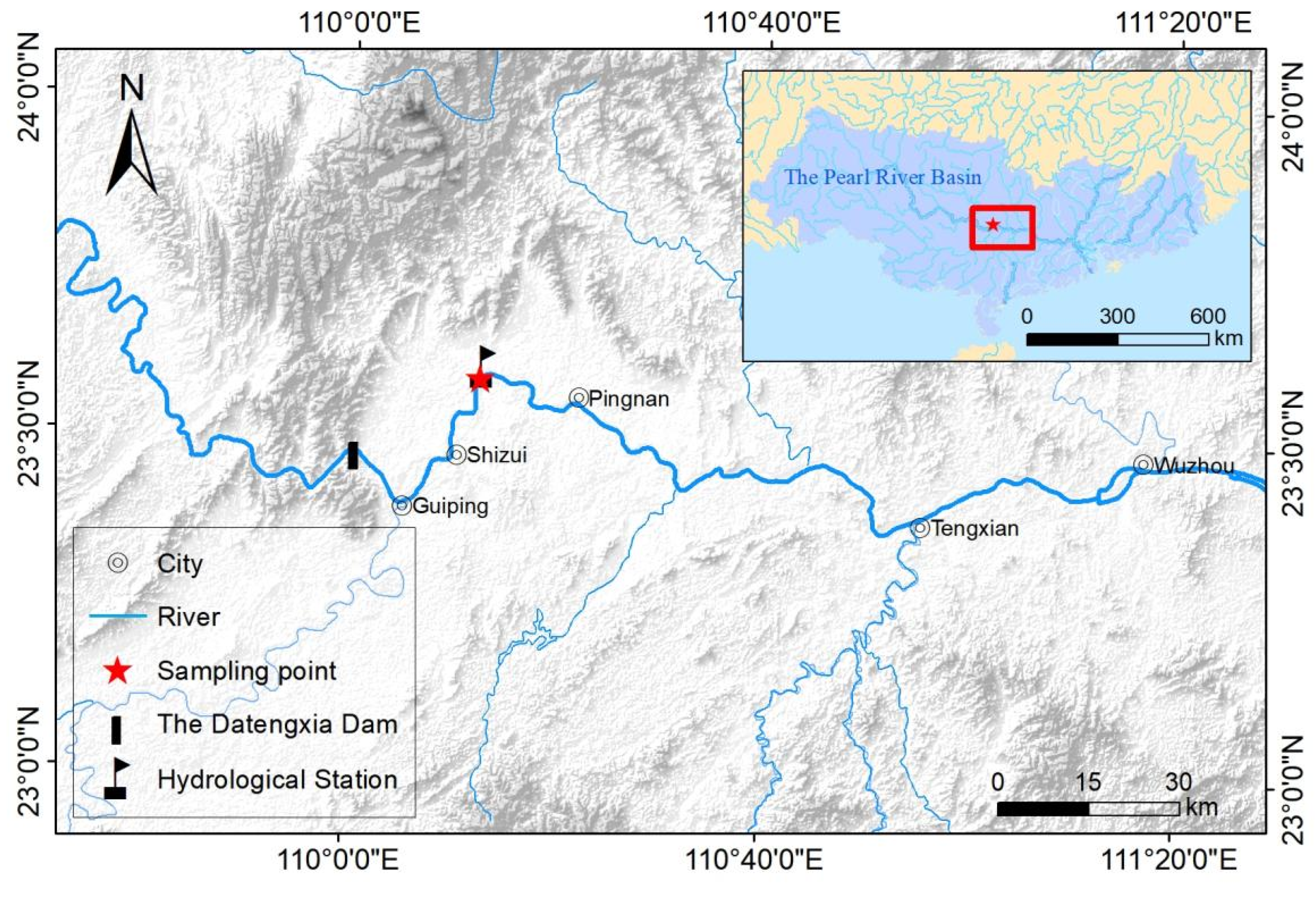
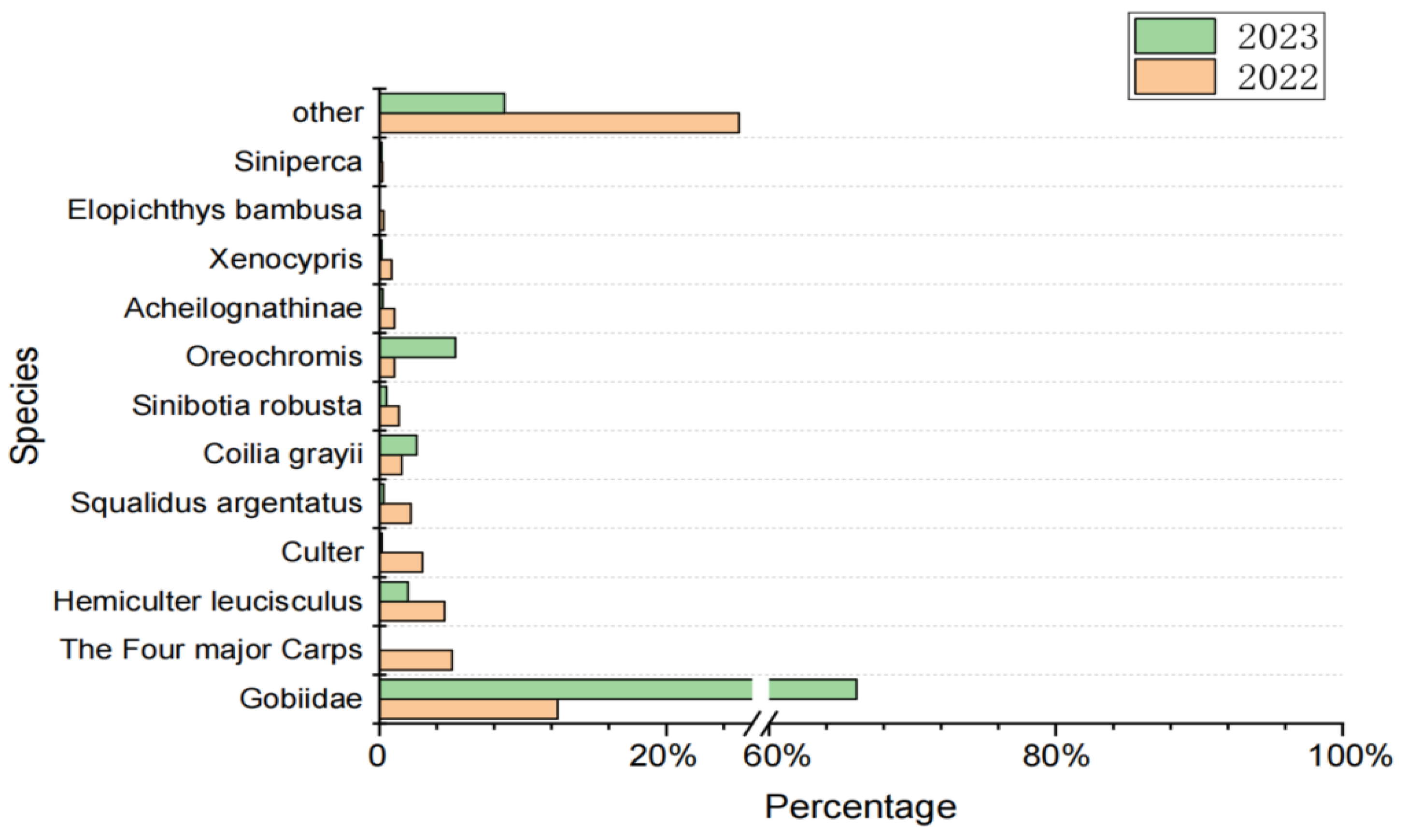
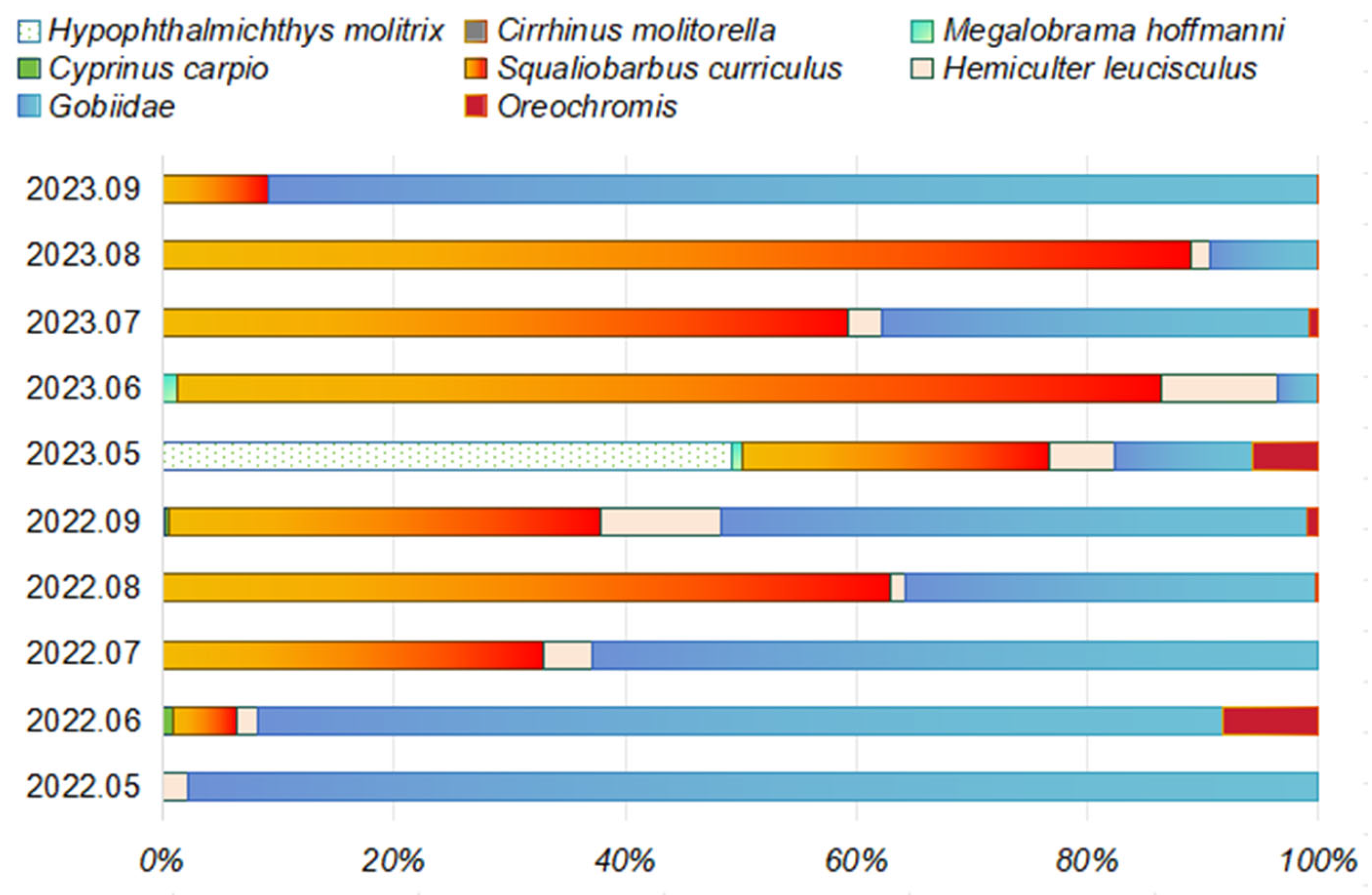
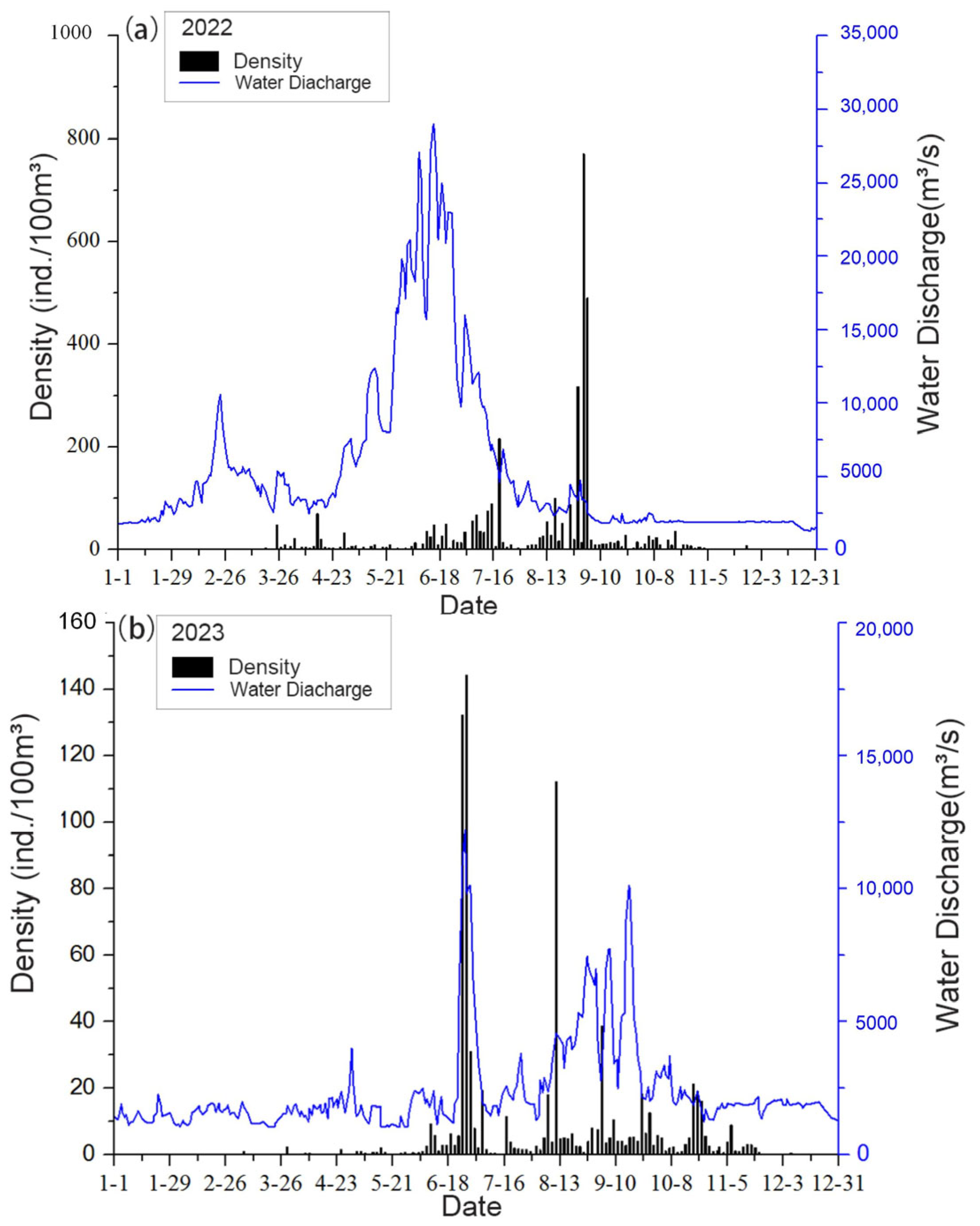
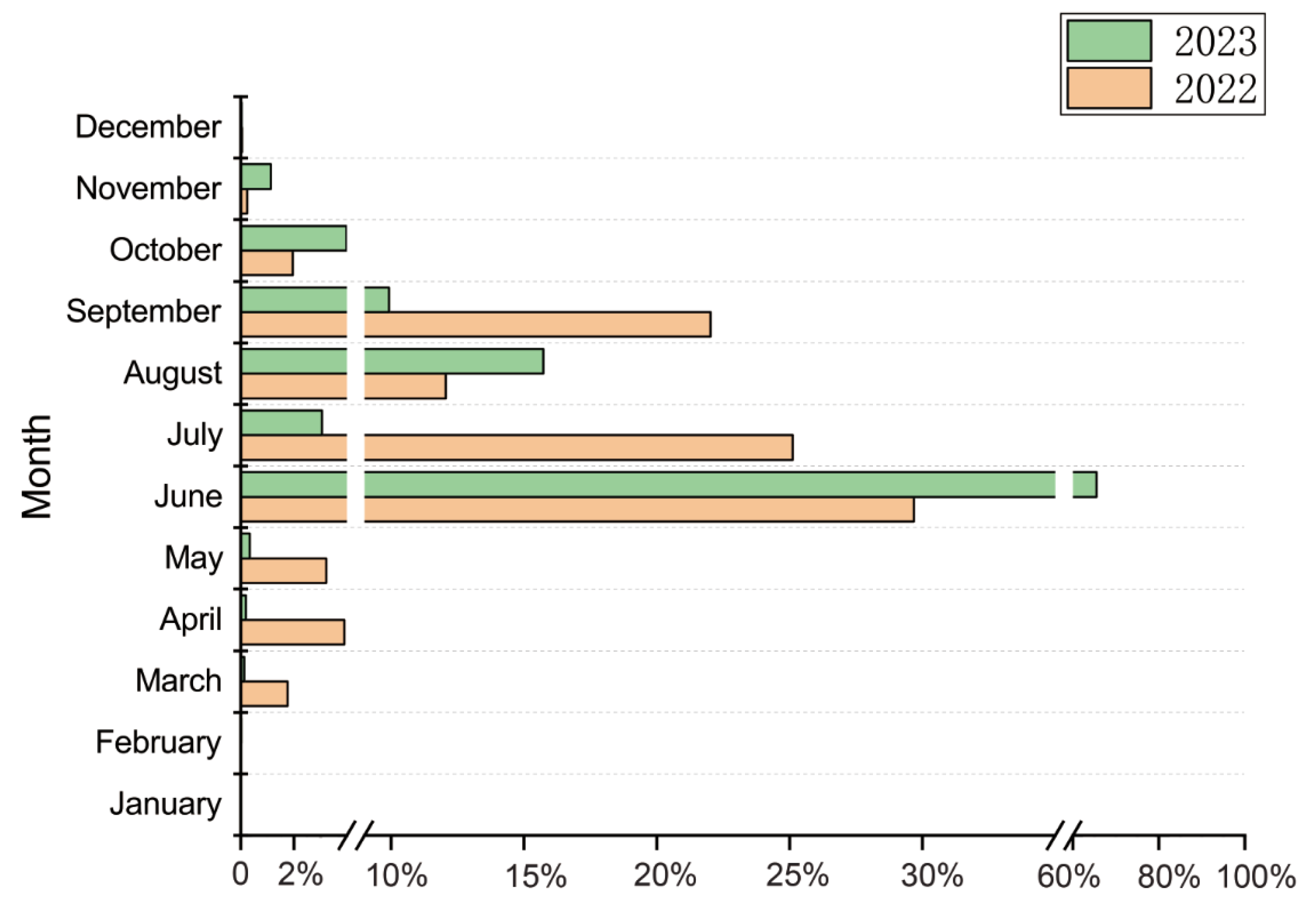
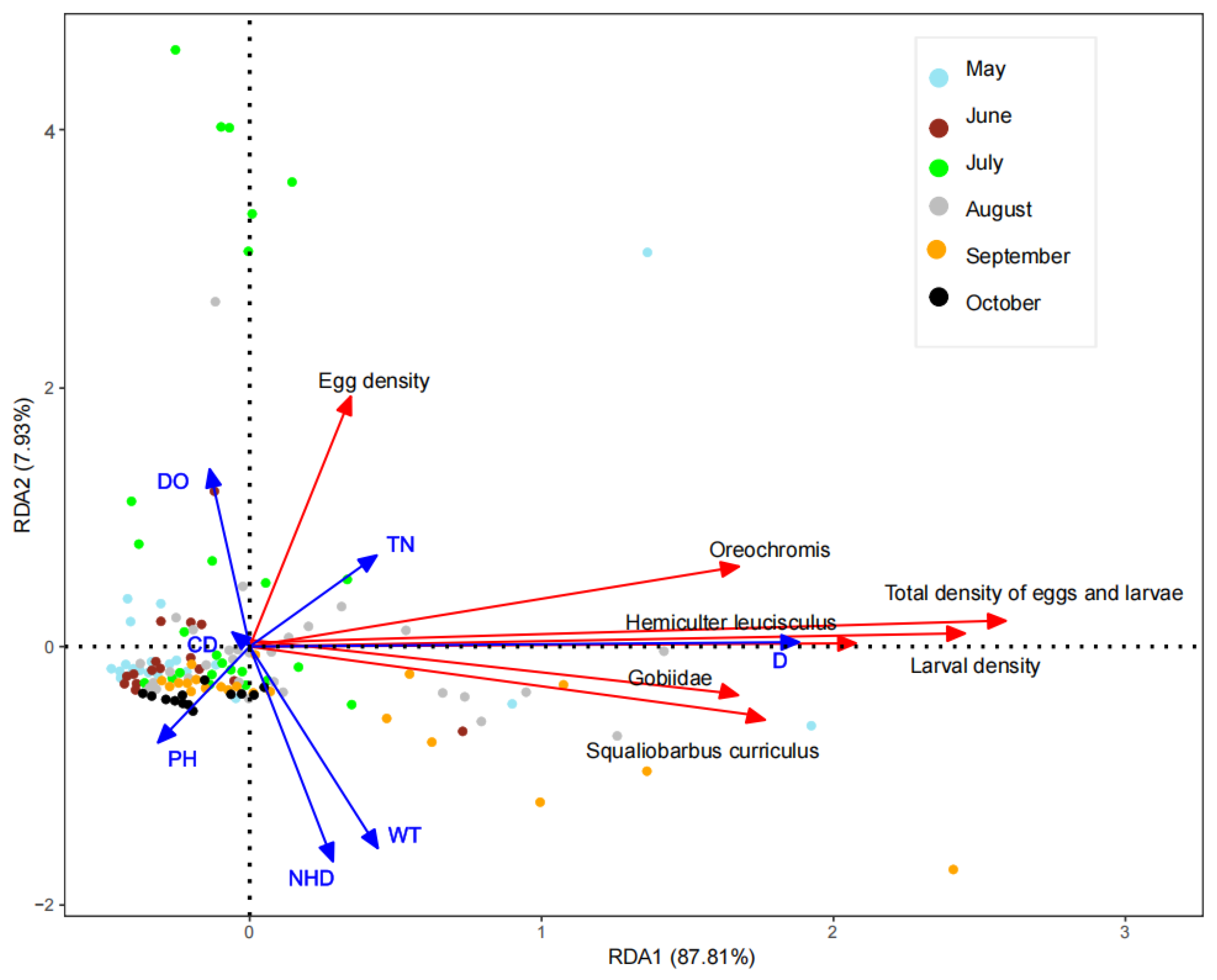
Disclaimer/Publisher’s Note: The statements, opinions and data contained in all publications are solely those of the individual author(s) and contributor(s) and not of MDPI and/or the editor(s). MDPI and/or the editor(s) disclaim responsibility for any injury to people or property resulting from any ideas, methods, instructions or products referred to in the content. |
© 2025 by the authors. Licensee MDPI, Basel, Switzerland. This article is an open access article distributed under the terms and conditions of the Creative Commons Attribution (CC BY) license (https://creativecommons.org/licenses/by/4.0/).
Share and Cite
Li, H.; Chen, W.; Wang, D.; Lin, X.; Yu, L.; He, C.; Li, J.; Li, Y. The Status of the Early-Stage Fish Resources and Hydrologic Influencing Conditions in the Guiping Section of the Xunjiang River. Sustainability 2025, 17, 5930. https://doi.org/10.3390/su17135930
Li H, Chen W, Wang D, Lin X, Yu L, He C, Li J, Li Y. The Status of the Early-Stage Fish Resources and Hydrologic Influencing Conditions in the Guiping Section of the Xunjiang River. Sustainability. 2025; 17(13):5930. https://doi.org/10.3390/su17135930
Chicago/Turabian StyleLi, Huifeng, Weitao Chen, Dapeng Wang, Xiaoyu Lin, Li Yu, Chengdong He, Jie Li, and Yuefei Li. 2025. "The Status of the Early-Stage Fish Resources and Hydrologic Influencing Conditions in the Guiping Section of the Xunjiang River" Sustainability 17, no. 13: 5930. https://doi.org/10.3390/su17135930
APA StyleLi, H., Chen, W., Wang, D., Lin, X., Yu, L., He, C., Li, J., & Li, Y. (2025). The Status of the Early-Stage Fish Resources and Hydrologic Influencing Conditions in the Guiping Section of the Xunjiang River. Sustainability, 17(13), 5930. https://doi.org/10.3390/su17135930







